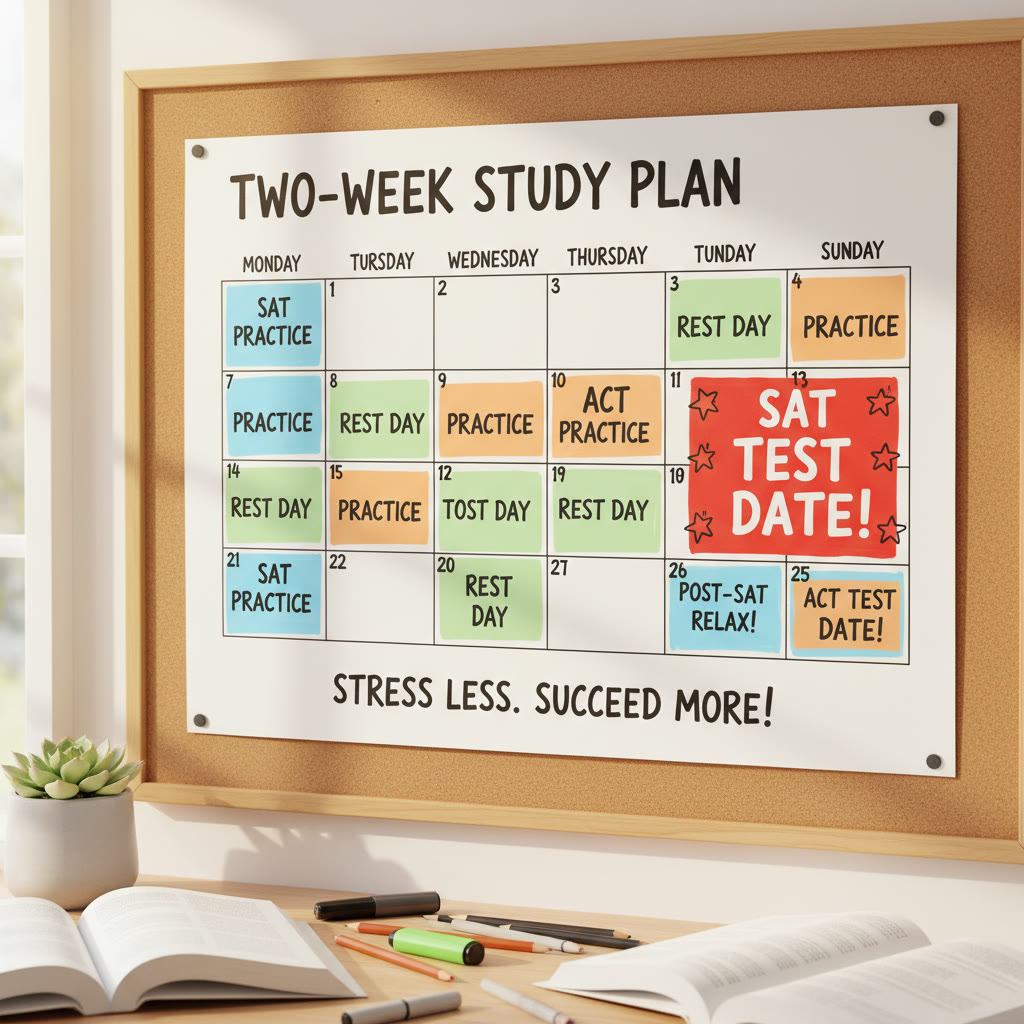How to Plan SAT Prep if You’re Also Taking the ACT
Deciding to take both the SAT and the ACT can feel like signing up for two marathons that happen to have a few shared miles. If you plan carefully, the effort you put in for one test will amplify your results on the other. If you rush, you’ll burn energy and time without gaining much. This guide is written for students juggling both exams: practical timelines, efficient study tactics, a realistic calendar, and how to use targeted help—like Sparkl’s personalized tutoring—when you need it.
Why students choose both tests (and why that’s smart)
Many colleges accept either test, and some schools accept superscores. Students take both to discover which one better showcases their strengths. The ACT rewards fast, broad reading and reasoning under pressure; the SAT emphasizes evidence-based reading and carefully structured math problems. Preparing for both exposes you to diverse question styles and often lifts your overall test-taking skills.

First steps: Take two diagnostic tests
Before you build a plan, find out where you stand. Take an official full-length SAT and an official ACT under timed conditions. The goal is not to get a perfect score on either; the goal is to identify strengths, weaknesses, and which test feels more natural.
- Timing: Simulate test-day conditions. No phone, timed sections, only approved breaks.
- Score goals: Note raw and scaled scores, and compare to college targets.
- Section-level insights: Which sections took the most time? Which question types caused the most slips?
These diagnostics will tell you if one test is an obvious primary and the other a fallback, or if you should pursue both equally. Many students discover they prefer one test by 3–6 percentile points; that’s often enough to focus primarily on the stronger test while keeping the other in play.
Set a realistic timeline
How much time you need depends on your diagnostic gap, weekly availability, and target schools. Here are three common timelines:
- Minimal prep (4–6 weeks): For students already scoring near target on diagnostics. Emphasis on timed practice and targeted review.
- Moderate prep (8–12 weeks): Most common. Allows for content review, mixed practice, and multiple full-length tests.
- Extended prep (3–6 months): For larger score improvements or for students balancing heavy coursework or extracurriculars.
If you’re preparing for both tests, add 2–4 weeks to your single-test timeline to allow for overlap practice and an extra diagnostic halfway through. For example, if a single-test plan calls for 10 weeks, plan 12–14 weeks when you’re doubling up.
Understand overlap and differences
Planning efficiently means leveraging overlap while respecting differences. Here’s a compact comparison to guide study choices.
| Feature | SAT | ACT |
|---|---|---|
| Score range | 400–1600 | 1–36 |
| Sections | Reading, Writing & Language, Math (no penalty for guessing) | English, Math, Reading, Science (no penalty for guessing) |
| Timing | About 3 hours total; reading 65 min, writing 35 min, math 80 min | About 2 hours 55 min; English 45 min, Math 60 min, Reading 35 min, Science 35 min |
| Question style | Evidence-based, data interpretation, multi-step math problems | Faster pace, more questions, straightforward math, science reasoning |
| Scoring nuance | Section scores combined; many colleges superscore | Composite average of section scores; many colleges superscore |
The key practical takeaways: content like algebra, grammar rules, and reading comprehension is reusable across both tests. The differences are mostly timing and question framing. Build a study plan that drills the shared skills first—algebraic fluency, reading for evidence, command of grammar—and then layer on test-specific timing drills.
Design a hybrid study plan
Your weekly plan should mix content work, targeted drills, timed sections, and full-length practice exams. Below is a sample 12-week structure you can adapt. Aim for consistency—three to six focused study sessions per week beats 12-hour cram days.
| Week | Focus | Practice |
|---|---|---|
| 1–2 | Diagnostics review, fundamentals (algebra, grammar, passage reading) | 2 SAT sections + 2 ACT sections weekly; short timed drills |
| 3–5 | Content deep dive (advanced algebra, geometry, punctuation, evidence-based reading) | One timed SAT practice test every 2 weeks, one ACT section daily rotation |
| 6 | Midpoint diagnostic and plan adjustment | Full SAT and ACT practice tests under test conditions |
| 7–9 | Round-the-clock timing and mixed practice, target weak areas | Weekly timed sections, alternating full-length practice tests |
| 10–12 | Polish, strategy, and final timing drills; taper practice before test | Final full-length tests; focus sessions on pacing and endurance |
This sample plan uses the first weeks to build reusable skills, a mid-plan checkpoint to recalibrate, and the last weeks to sharpen pacing and stamina. If you use a tutor or service like Sparkl, inject personalized sessions where they can target blind spots—tutors can accelerate recovery from weak areas and adjust the plan with AI-driven insights for faster gains.
Weekly study blueprint (detailed)
Here’s a practical weekly template for a student with about 8–10 hours available for test prep per week:
- 2 sessions (90 minutes each): Content mastery (math or grammar). Deep work: teach yourself, then immediately practice related problems.
- 2 sessions (60 minutes each): Timed section practice—rotate a SAT and an ACT section every week.
- 1 session (120 minutes): Mixed problem set—pick 20–30 questions across sections to practice switching gears.
- 1 session (90 minutes): Review mistakes and build error logs. Focus on why you made the mistake—concept, carelessness, or timing.
- 1 session (variable): Light review—flashcards, vocabulary, or pacing drills. Keep it low stress.
On weeks with a full practice test, substitute one content session for the practice test and leave the next day lighter.
Practice tests: cadence and purpose
Full-length practice tests are the single most predictive activity for score improvement. For a 12-week plan, aim for 5–7 full tests total across both exams: three of your primary test and two of the secondary, spaced out so you have time to review thoroughly.
- Before week 1: Two diagnostics (one SAT, one ACT).
- Midpoint (week 6): One full SAT and one full ACT under test conditions.
- Weeks 8–12: Two to three more full tests, alternating formats and simulating test-day timing.
After each practice test, spend substantial time on review. The review is where the score gains are made: identify error patterns, then build mini-lessons around those patterns.
How to handle timing differences and pacing
The SAT and ACT each have their own pacing quirks. If you try to use one pacing strategy for both, you’ll likely underperform on one test.
- SAT: A few long reading passages and multi-step math problems. It’s often better to slow down slightly to ensure you’re extracting evidence correctly. Practice labeling passage paragraphs and mapping argument structure.
- ACT: More questions and a faster pace. You must triage ruthlessly—skip questions that will cost time without much expected gain. Practice quick elimination techniques and average time per question targets.
Work on speed with accuracy drills: set a small timer for clusters of questions and slowly reduce the time as accuracy improves. Both tests reward smart guessing—because there’s no wrong-answer penalty, unanswered questions are missed opportunities.
Managing cognitive load and burnout
Studying for two standardized tests can be mentally expensive. Protect your energy so you can study consistently for months.
- Build in recovery: one light day per week and one full rest day every two weeks.
- Mix intense drills with lower-energy activities (vocabulary, mental math, flashcards).
- Use short, focused sessions. When concentration dips, switch task types rather than power through.
If you’re juggling schoolwork, sports, or jobs, a tutor can consolidate hours of inefficient study into high-yield sessions. Sparkl’s personalized tutoring provides 1-on-1 guidance, tailored study plans, and expert tutors who can accelerate improvement while minimizing burnout. Their AI-driven insights can also highlight which mistakes are worth chasing and which represent noise.
Example case studies
Real students follow different paths; here are two short examples to illustrate choices.
Case A: Sarah (prefers ACT slightly)
Diagnostics: SAT 1250, ACT equivalent ~25. She feels more comfortable with the ACT’s straightforward questions. Plan: Focus on ACT as primary, but keep weekly SAT long-reading practice and two full SAT tests mid-plan and pre-test. Outcome strategy: Submit best ACT scores; submit SAT if practice shows an improvement.
Case B: Mateo (balanced)
Diagnostics: SAT 1300, ACT 27—virtually parallel. Plan: Dual-track approach. First half of the schedule focuses on content that overlaps (algebra, reading evidence). Second half emphasizes separate pacing drills and alternates full-length tests. Result: He built pacing for ACT and the deep-reading skills for SAT; submitted higher SAT score to colleges that favored it.
Two final weeks: tapering and test-week strategy
Your last two weeks should shift from learning to consolidation. The brain needs repetition and rest—avoid cramming new concepts at the eleventh hour.
- Week -2: Take one final full-length practice for each test. Review high-impact errors. Reduce study time by 10–20% to begin tapering.
- Week -1: Focus on strategy and pacing. Do short, timed sections. Revisit your error log. Sleep, nutrition, and light exercise become priority activities.
- Two days before test: No full-length tests. Light review, confirm test-day logistics, and relax.
- Test day: Arrive early, with snacks and materials. Trust your practice.
If you’re testing both tests within a short window, plan your rest carefully. For example, if you take the ACT on a Saturday and the SAT the following Saturday, use the intervening days for light review and two short timed sections rather than full practice exams.
What to focus on when you can only pick one test
Sometimes budget, time, or energy forces a choice. If you must prioritize one test:
- Choose the one you naturally score higher on or the one that fits your cognitive strengths (speed vs. depth).
- Consider test dates and school deadlines; pick the test that gives you the best timeline.
- If your diagnostics are close, pick the test with simpler logistics for you—location, date availability, or comfort.
Even if you pick one, keep light exposure to the other test for flexibility. Many students take the other exam only if their first attempt is below target.
Using help wisely
Not all study time is equal. One hour of deliberate, corrected practice with feedback is typically worth more than four hours of passive review. If you can, invest in targeted support.
- Private tutoring: Personalized tutoring gives immediate feedback, corrects misconceptions, and provides pacing strategies. Short, frequent sessions focused on your error patterns often yield the best ROI.
- AI-driven tools: They can analyze patterns across practice tests and suggest which problem types to prioritize, saving you time.
- Group classes: Useful for structure and accountability, but choose them only if they match your pace and offer practice under timed conditions.
Sparkl’s personalized tutoring is an example of combining expert tutors with AI-driven insights: 1-on-1 guidance, tailored study plans, and targeted drills to accelerate recovery from weak spots while keeping the overall plan balanced between SAT and ACT demands.
Common pitfalls and how to avoid them
- Pitfall: Treating the tests as identical. Fix: Study for shared content, then practice test-specific timing separately.
- Pitfall: Over-testing without review. Fix: After every practice test, spend more time reviewing than taking tests.
- Pitfall: Ignoring sleep and nutrition. Fix: Prioritize routine; performance is fragile when your brain is tired.
- Pitfall: Chasing perfection on low-impact errors. Fix: Use error logs to prioritize frequent, high-cost mistakes first.
Quick checklist for the week before test day
- Confirm test registration and location details on paper and in your phone.
- Pack acceptable calculators, extra batteries, ID, admission ticket, snacks, and water.
- Review only light content and pacing drills; avoid heavy learning sessions.
- Get consistent sleep and moderate exercise.
- Plan your travel, including backup options for delays.
Final thoughts
Preparing for the SAT while also taking the ACT is a challenge, but it’s a manageable one with the right structure. Start with diagnostics, build a hybrid plan that leverages overlap, commit to consistent timed practice, and review deeply. Use full-length tests as checkpoints, and protect your energy to avoid burnout. When you need efficiency—especially balancing school and other commitments—consider targeted 1-on-1 help. Personalized tutors and AI-driven insights can cut months of aimless practice into weeks of focused progress.
Above all, remember that progress is cumulative. Small, daily improvements add up. Plan realistically, practice deliberately, and let each practice test teach you how to take the next one smarter. You’ve got this.

















No Comments
Leave a comment Cancel